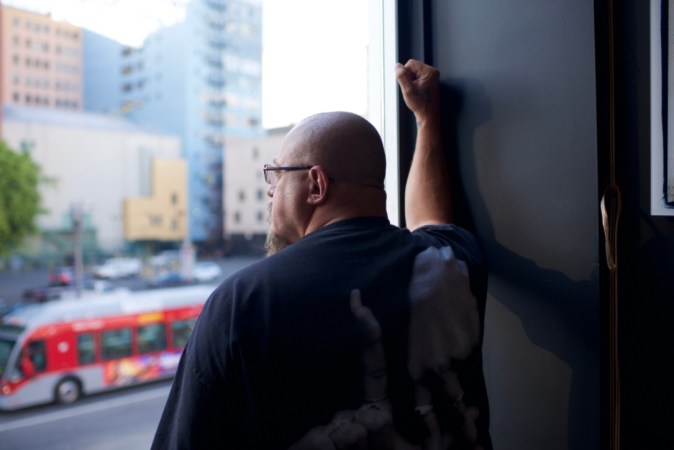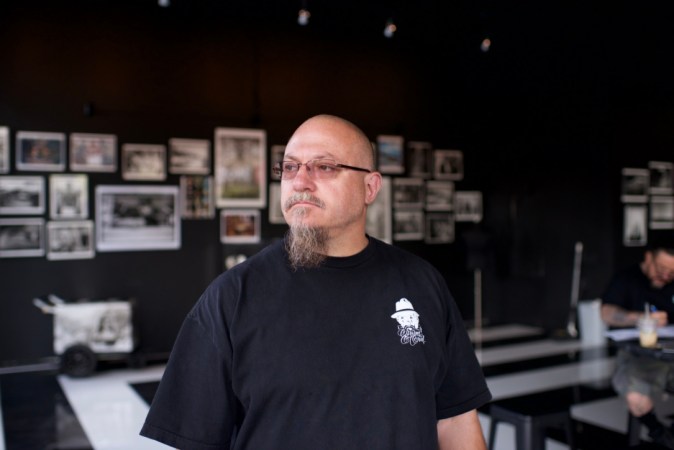For twenty-five years, world-renowned Chicano photographer Estevan Oriol has been inspired by an unwavering love for Los Angeles and a calling to capture Chicano street culture in photography.
As gentrification continues to negatively impact communities of color throughout the United States, Oriol’s photographs are visual testimonies into the lives of LA Chicanas and Chicanos whose bodies have been deeply shaped by the constant threat of state sanctioned violence.
But for Oriol, himself a member of the communities that he choses to photograph, documenting LA street life has been rooted in an concerted attempt to offer audiences complex and nuanced portraits of Angelenos whose image, he believes, tend to be distorted by negative media depictions.
While other artists from around the world in cities like New York and Mexico City have often found inspiration in the intimacy of physical, urban contact, Oriol has situated his subjects amid Los Angeles’ endless geographic sprawl in a way that reconciles the beauty, pain, and complexity that his lens has captured over the course of twenty-five years.

We sat down with Estevan to discuss his career and the resurgence of interest in Chicano lowrider street culture.
Take me through your early days as an LA youth. How did you begin your career?
It all started back in the early 1980s when I used to do construction during the day and worked as a doorman at night for the clubs here in LA. I started meeting a lot of people who were in the music scene from working the doors at clubs, like House of Pain, Cypress Hill, and the Red Hot Chili Peppers.

Around that same time, I was taking photos with a Super 8 camera. I would show the photos to magazines who were doing interviews with Cypress Hill, and they ended up using some of the pictures. With the lowriding, there was a Japanese guy named Oishi who was a car dealer in Japan. He had a friend who ran a magazine in Japan who wanted photos of the lowrider scene out here and he asked me to do it. I had a monthly job with a magazine and it was a two-page spread every month. We called it “low life” for lowrider lifestyle, and that was in 1994/1995. That’s how I got started with lowrider photos, because Lowrider Magazine never wanted to hire me, so I started finding alternative routes to get my photos out there. I had a different hustle than everyone else.

I had a different hustle than everyone else.
Your photos are painfully honest. They invite us to experience a sense of intimacy that is hard to capture. How do you connect with the people you photograph? What’s your process like?
I had a lowrider before I had a camera. So I was already in that world. I was already lowriding and hitting switches and everything. But I was one of the only ones with a camera at the functions. The magazines would only take photos at the studios, with a model in a bikini in some white pumps. I wanted people to see more what it was like driving down a freeway, at a function where cars are just hoppin’ for fun, without the marker, what it was like for you and your homies to drive down the street, I wanted people to see all that kind of shit. Lowrider Magazine had the car show covered, so I wanted people to see the rest of it. I found my own lane and stayed there.

How much has LA lowrider culture changed since you were first introduced to it?
When I first started lowriding, there were more younger people involved, and it was off the hook. The car shows were all lowrider gangsters and girls. Now it’s all those people and their families and their children and they’re keeping the culture alive. But you don’t see too many youth at the car shows, today. Back in the day it was all Chicano youth. There were Mexican guys who were building their cars and there were African Americans who were building their cars and trying to join crews. Everybody would go to the car shows before. They knew the shows would be on and crackin’. It was all about cleaning your ride and getting it all hooked up and getting phone numbers all day. If the car show was on a Saturday we got enough numbers to talk and party with girls until the next car show. Now it’s more family oriented. It’s a more mature crowd.
In the 1990s if you had a lowrider, you were a target for cops. Now, the cops are younger. They grew up seeing all their music heroes with lowriders, and its different.
There’s been a recent resurgence in Chicano street subculture throughout the United States and the world. What do you think about it?
I think its cool. At first I thought it was weird that everyone was dressing up like a cholo or chola. They weren’t doing that when it was 20 or 30 homies chillin’ on the block. If you wore baggy pants and a big shirt or certain pair of shoes, you were in it to win it. You were walking down a line there were consequences to. Now it’s safe to dress that way. There have been gang injunctions and you aren’t allowed to have more than three gang members in one spot. So you’re not going to run into those streets where there’s 10, 20, 30 homies and ask yourself, ‘how do I get myself out of this one?’
I remember cruising to Hollywood boulevard and sometimes gangster fools would hit you up and sometimes if you had beef with them other things would happen. In the 1990s if you had a lowrider, you were a target for cops. You were a rolling violation for them and you stuck out a mile away. Now the cops are younger and they grew up seeing all their music heroes with lowriders and its different. When they see a lowrider now they’ll give you a thumbs up and they say what’s up and they might pull you over and will want to take a selfie with it. That’s how you know times have changed. It’s cool that you can bring out a ride and more people appreciate it now.
How have Chicano culture and lowriders become so popular in places like Japan?
Japan has been interested in lowriders since the 1980s. They have their own version of the lowrider and they have their own magazines. They made their magazines better than our magazines with better layouts, better photography, better paper, design, and once they got a hold of the lowrider shit, they did it better than we did. They have invented shit that we don’t even know about. They’ve master minded stuff and have brought a lot to the game. The Japanese go hard. They try to break their cars. They’re hitting switches as hard as they can. They’re just fucking beasts over there. And they love us and show the most respect for us.
I’m the only 50 year old millennial in LA. I’m out here to get this.
Did you ever imagine you would achieve this level of success? What does it mean to have traveled the world because of your art?
It feels great. It means that I have a lot of work to do. I’m 50 years old now and I’m the only 50 year old millennial in LA. I’m out here to get this. I’ve been to 56 countries and I’m not even halfway done. I’m trying to see the whole world. LA is my home, I love LA, I always come back. I’ve never lived anywhere else, but I do want to see everywhere else. That’s my mission.
You’ve taken some pretty incredible photos throughout your career. Is there any particular photo that stands out amongst the rest?
I’ve photographed a lot of famous people: Eminem, Dr. Dre, Robert Deniro, Dennis Hopper, and Al Pacino. My most memorable photo has been the LA fingers photo because that was the biggest and it’s all over the galaxy now. But I have different shots of homies in the ‘hood who might not be anyone in the celebrity world but they are somebody in the ‘hood. People are people to me. Just cause you’ve been in a movie or a magazine doesn’t mean you are better. You could do construction or wash dishes, it doesn’t matter. There’s pictures that I’ve shot of one homie from a gang in Santa Monica – he passed away of cancer – and before he died he asked his brother to get the photo from me that I took 20 years ago and frame it and put it on his casket. That fucked me up man. It was touching. It was an honor that someone would want to put that on their casket.
So as long as I have the opportunity, I’m going to go as hard as a I can – I’m smashing from sun up to sun down.
How do you reconcile the idea that some of the people who you’ve photographed over the years can no longer see their image. What’s it like to look at a photo of an old homie and realize that they may have been lost to street violence or have been incarcerated?
It’s sad. I just lost a homie today who overdosed. I’m here and they’re not, so I’m going do it for them. I still have the opportunity to do it and they don’t so I’m grateful man, fuck. I can sit here and have a ten-dollar coffee and look at my pictures. Today we went and got these ten-dollar coffees and they had this little bottle of juice that had cayenne pepper, jalapeño, lemon, and that bullshit cost five dollars and it tasted like shit. But I could do that shit, and my homies can’t because some of them are in prison or dead. So as long as I have the opportunity, I’m going to go as hard as a I can – I’m smashing from sun up to sun down.




